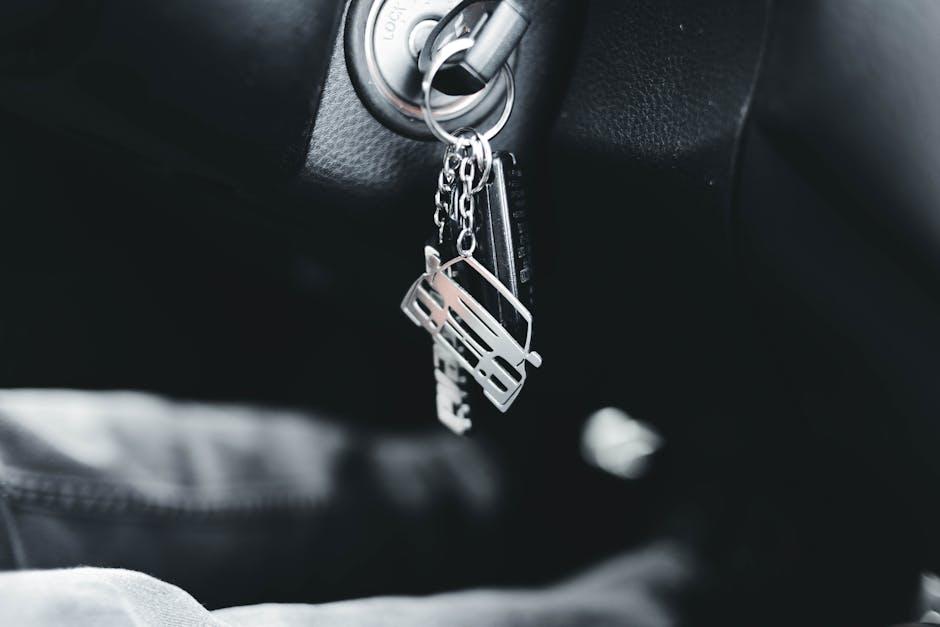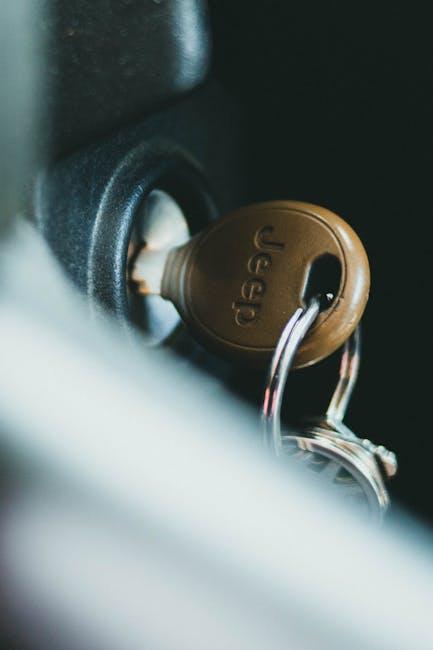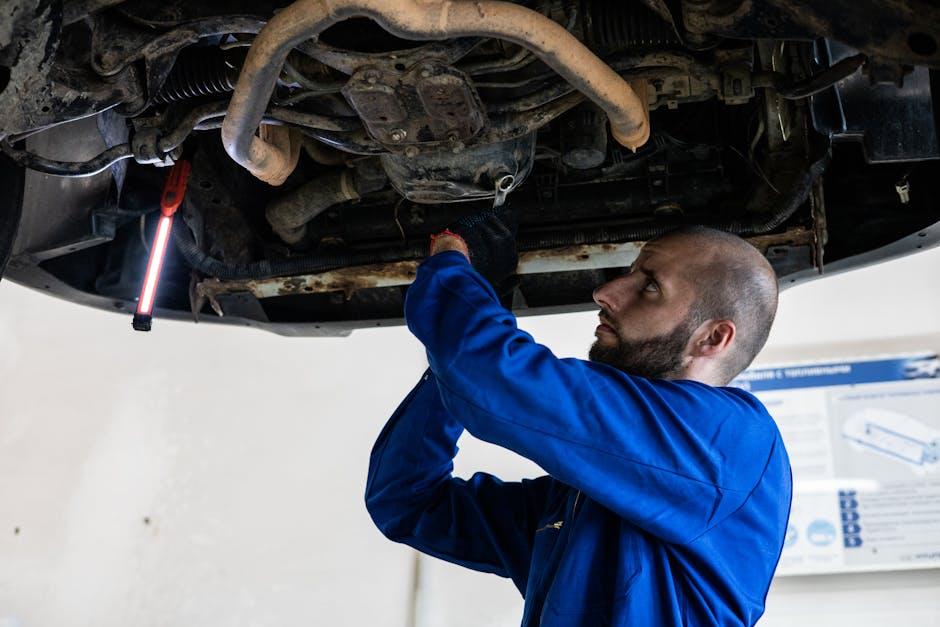Imagine turning the key in your car’s ignition, anticipating the familiar roar of the engine, only to be met with a disheartening silence or a series of frustrating clicks. The culprit behind this everyday frustration is often a struggling car starter, an unsung hero responsible for bringing your vehicle to life. Understanding the symptoms of a bad car starter is crucial for every driver, as early detection can save you from unexpected breakdowns and costly repairs. In this article, we’ll explore the telltale signs that signal your starter may be failing, helping you navigate the road ahead with confidence and clarity.
Table of Contents
- Common Signs Your Car Starter Is Failing
- Understanding the Clicking Noise When Starting
- Why Your Engine Won’t Turn Over and What It Means
- Interpreting Dim Dashboard Lights and Starter Issues
- How to Diagnose Starter Problems Before They Escalate
- Tips for Maintaining Your Starter to Avoid Costly Repairs
- Q&A
- Future Outlook

Common Signs Your Car Starter Is Failing
Recognizing when your car’s starter is on the fritz can save you from unexpected breakdowns and costly repairs. One of the most noticeable signs is a distinct clicking sound when turning the key, accompanied by the engine’s failure to crank. You might also experience a sluggish or intermittent start, where the engine hesitates or starts only after multiple attempts. In some cases, the dashboard lights may flicker when you try to start your vehicle, indicating that power is struggling to reach the starter motor.
Additional symptoms often include:
- Grinding noises: When gears within the starter don’t engage properly.
- Smoke or burning smell: Indicative of electrical issues or overheating starter components.
- Starter stays on after ignition: This continuous operation can drain your battery and damage parts.
| Symptom | Cause | Immediate Action |
|---|---|---|
| Clicking sound | Weak battery or faulty starter relay | Check battery, try jump-starting |
| Grinding noise | Worn-out starter gear teeth | Inspect and replace starter |
| Intermittent start | Loose wiring or bad solenoid | Secure connections, test solenoid |

Understanding the Clicking Noise When Starting
When you turn the key and hear a persistent clicking noise, it often points to a starter struggling to engage properly. This repetitive clicking can be caused by a few underlying issues such as a weak battery, corroded battery terminals, or worn-out starter components. The starter motor is attempting to draw power to turn the engine over, but insufficient current or mechanical failure inside the starter prevents it from doing so. The sound is often a sign that electricity is reaching the starter solenoid, but the motor itself isn’t spinning as it should.
Identifying this symptom early can help prevent complete starter failure. Here are some common causes associated with the clicking sound:
- Battery problems: Low voltage or poor connections reduce power supply.
- Starter solenoid issues: Faulty solenoid can cause incomplete engagement.
- Damaged starter motor: Worn brushes or faulty gears stall the motor.
| Cause | Symptom | Recommended Action |
|---|---|---|
| Weak Battery | Rapid clicking, dim dashboard lights | Charge or replace battery |
| Corroded Connections | Intermittent clicking noise | Clean terminals and cables |
| Starter Motor Fault | Single click or grinding sound | Starter replacement or repair |

Why Your Engine Won’t Turn Over and What It Means
When you try to start your vehicle and the engine refuses to turn over, it’s often a clear signal that something is amiss in the starting system. The most common culprit is the starter motor itself, but it could also be related to issues such as a dead battery, faulty ignition switch, or corroded electrical connections. Understanding the root cause behind this problem can save you time and unnecessary replacement costs.
Some signs that point specifically to starter issues include:
- Clicking sounds when turning the key, but no engine rotation
- Intermittent starting where the engine sometimes cranks and sometimes doesn’t
- Starter remains engaged even after the engine starts, creating a grinding noise
- Dimming dashboard lights during attempts to start, indicating electrical strain
| Symptom | Potential Meaning |
|---|---|
| Clicking noise | Weak solenoid or battery issue |
| No sound, no movement | Faulty ignition switch or broken starter |
| Grinding noise | Worn-out starter gear or flywheel damage |
| Engine cranks slowly | Battery low charge or poor electrical connections |

Interpreting Dim Dashboard Lights and Starter Issues
When your car’s dashboard lights appear unusually dim or flicker when you try to start the engine, it’s a classic signal that the starter system might be struggling. These subdued lights can indicate insufficient power being delivered, often due to a failing starter motor or a weak battery connection. Watch out for signs such as sluggish cranking, where the engine turns over slowly or inconsistently, and a noticeable drop in the brightness of your instrument cluster lights when you turn the key. These symptoms often point to electrical resistance or a worn starter solenoid struggling to engage properly.
Understanding these warning signs can save you from unexpected breakdowns. Check carefully for:
- Clicking sounds: Repeated clicking without engine turnover suggests the starter isn’t engaging fully.
- Dashboard dimming: Lights dim sharply when starting attempts are made, hinting at starter or battery strain.
- No crank action: The engine remains silent and stationary despite turning the key.
- Intermittent issues: Sometimes the car starts fine; other times, it struggles or fails completely.
| Symptom | Possible Cause | Recommended Action |
|---|---|---|
| Dim dashboard lights when starting | Low starter current or battery voltage drop | Test battery and starter connections |
| Rapid clicking noise | Faulty starter solenoid | Inspect or replace starter solenoid |
| Engine cranks slowly | Worn starter motor or weak battery | Check starter motor health and battery charge |

How to Diagnose Starter Problems Before They Escalate
Before you find yourself stranded, it’s crucial to recognize the subtle signs that your car’s starter is on its last legs. Begin by listening carefully when you turn the key or push the start button. Clicking sounds without engine turnover, intermittent starting, or a whining noise that doesn’t lead to ignition are often early warnings of starter wear or electrical issues. Look out for dashboard lights dimming unusually during startup attempts—this can indicate the starter drawing excessive current and potentially draining the battery faster than normal.
Performing a few simple tests can help pinpoint the problem early. Check these common indicators:
- Slow engine crank: The engine turns over slowly or hesitates to start
- Starter relay noise: Clicking or buzzing sounds from under the hood
- Intermittent ignition failure: Engine sometimes starts fine, other times won’t respond
- Dashboard warning lights: Battery or check engine lights illuminating during startup
If you notice two or more of these symptoms, it’s wise to have your starter tested by a professional. Addressing starter issues early can save you from unexpected breakdowns and costly repairs.
| Symptom | What It Could Mean |
|---|---|
| Repeated Clicking | Weak starter motor or low battery voltage |
| No Sound When Starting | Faulty starter solenoid or wiring issues |
| Slow Cranking | Worn starter drive or weak battery |
| Smoke or Burning Smell | Overheating starter motor or electrical short |

Tips for Maintaining Your Starter to Avoid Costly Repairs
Protecting your starter from premature failure begins with regular attention to its condition and surrounding components. Start by ensuring the electrical connections are clean and tight, as corrosion or loose wiring can increase resistance and strain the starter motor. Periodically inspect the battery terminals and cables; a weak battery can cause the starter to work harder, accelerating wear. Additionally, avoid extended cranking sessions—if your car doesn’t start within a few seconds, pause and try again after a short rest to prevent overheating the starter solenoid.
Incorporating simple habits into your routine can effectively extend the lifespan of your starter and save you from unexpected costly repairs. Consider the following maintenance essentials:
- Regular electrical system checks to detect any voltage drops or wiring issues early.
- Keeping the engine clean to prevent dirt and debris from damaging starter components.
- Ensuring proper lubrication of the starter gear interface to minimize friction.
- Promptly addressing unusual noises such as grinding or clicking sounds that may signal early problems.
| Maintenance Task | Recommended Frequency |
|---|---|
| Battery Cable Inspection | Every 6 months |
| Starter/Lubrication Check | Annually |
| Electrical System Diagnostic | Every 12 months |
| Clean Engine Bay | Every 6 months |
Q&A
Q: What are the common signs that indicate a car starter might be failing?
A: If your car struggles to start or doesn’t start at all, accompanied by unusual noises like clicking or grinding, these are classic clues your starter could be on its last legs. Other signs include dimming dashboard lights when turning the key and intermittent starting issues.
Q: Why does my car make a clicking sound when I try to start the engine?
A: That persistent clicking often means the starter motor is getting power but failing to engage the engine flywheel properly. It could be due to worn-out starter components, weak battery connections, or a faulty solenoid.
Q: Can a bad starter cause my engine to turn over slowly?
A: Yes. A worn or failing starter motor may struggle to spin the engine at the necessary speed, causing slow cranking. This sluggish start can also be mistaken for battery problems, so it’s crucial to check both systems.
Q: What happens if I ignore the symptoms of a faulty starter?
A: Ignoring starter issues can leave you stranded unexpectedly, leaving your car completely unresponsive. Additionally, repeated attempts to start the engine with a bad starter can cause damage to related components, increasing repair costs.
Q: Are there any dashboard warning lights specific to starter problems?
A: While there isn’t a dedicated starter warning light, signs such as the check engine light or battery light might illuminate due to the electrical strain caused by starter faults. It’s a good idea to have your vehicle diagnosed if these lights appear in conjunction with starting issues.
Q: How can I distinguish between a bad starter and a dead battery?
A: A dead battery usually results in no sound or very faint clicking when attempting to start. A bad starter often produces repetitive clicking or grinding noises. Testing the battery’s voltage and jump-starting the car can help narrow down the culprit.
Q: What’s the best way to address starter symptoms early?
A: If you notice the odd noise or sluggish start, seek a professional automotive inspection promptly. Early diagnosis can prevent sudden breakdowns and might save on costly repairs by addressing the issue before the starter fails completely.
Q: Is it possible to fix a bad starter, or does it always require replacement?
A: In some cases, starters can be repaired by replacing worn brushes, solenoids, or other components. However, often replacement is the most reliable and cost-effective solution to restore dependable starting performance.
Future Outlook
In the end, recognizing the subtle and not-so-subtle signs of a failing car starter can save you from unexpected breakdowns and costly repairs. Whether it’s the stubborn click, a sluggish crank, or complete silence when you turn the key, these symptoms serve as your vehicle’s way of signaling a call for help. Staying attentive to these warning signs ensures that your car starts reliably every time, keeping your journeys smooth and worry-free. After all, a healthy starter is the quiet hero that gets you moving—don’t wait until it’s too late to give it the attention it deserves.

